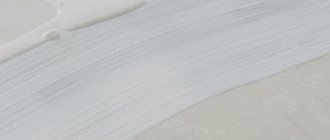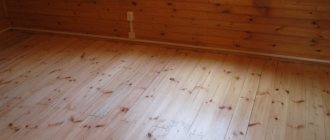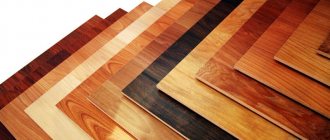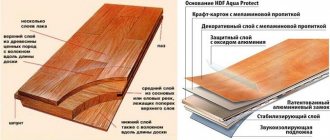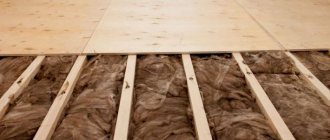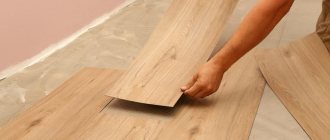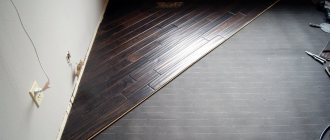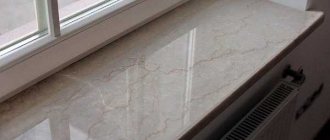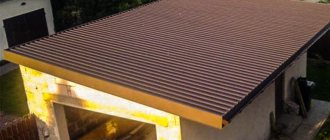The installation of floorboards is planned in both residential and non-residential rooms. The most common and optimal materials for laying wooden floors are oak and ash; aspen and alder are used a little less frequently. These types of wood have excellent strength and wear resistance. For example, oak floors look stylish and expensive, especially when varnished.
Quality classes of floor boards
Depending on the area of use of the board, it is necessary to select lumber according to the characteristics of its grade:
- premium types of wood from expensive tree species (often labeled as “extra” and “prima” grades) are used as a finishing coating. The wooden flooring has no defects, the surface of the product is even, smooth, durable;
- wood of classes A and B, as well as AB, can be used as a finishing coating. There may be some defects on the wooden flooring (resin pockets, knots, minor non-through cracks and chips). The cost of lumber made from wood of classes A, B and AB is an order of magnitude lower than premium grades;
- Class C wood is used exclusively to create a subfloor in the house. Wooden flooring has a significant number of visible defects that cannot be corrected even with additional finishing.
It should also be taken into account that the quality of the board depends on the type of wood from which it is made. The higher the grade of wood, the more expensive and reliable the finished finishing coating will be.
| Purpose of the board | Peculiarities |
| For subfloor | Inexpensive, unedged material can be used (unless a flat base is required for the final coating). Grade "C". |
| For the bath | The boards must be resistant to temperatures and moisture. Untreated boards and resin release are not allowed. Larch is mainly used. Grade “C”, “B”. |
| For home and apartment | Tongue and groove boards that fold into a flat sheet are best suited. Only well-processed, durable boards are used. The most popular covering is larch. Grade “A”, “Extra”. |
| For an open veranda | Only the most durable and moisture-resistant boards are used. It is necessary that the surface of the board be corrugated (terrace board) to avoid accumulation of moisture and icing. Any variety, depending on your wishes. |
What else to pay attention to
When choosing, pay attention to the correct geometry so that all edges are smooth. It is also important to ensure the same thickness along the entire length of the board. It is important to check tongue and groove boards for the presence of identical groove elements, since different locks will not allow the floor to be laid without gaps.
Before buying, try to take several boards and connect them together, if everything is in order and this thing looks as it should, that is, smoothly, then you can safely purchase this material. The quality of the material can also be seen in the end part, where even rings of the age of the tree are observed.
Protecting wood from external influences is the key to the reliability of a country houseWood is a natural raw material and a wonderful material
All about wooden lining - quality assessment, advantages of use and characteristics of the finishing material
Wood types for floors
If you decide to create a finishing floor covering made of wood, then you should take into account the characteristics and properties of different types of wood.
1Softwood
Lumber made from such wood contains natural resins, which serve as a natural antiseptic. The finishing coating will not succumb to rotting or the formation of fungus in conditions of high humidity. The vapor permeability of coniferous wood boards is very good, due to which it will be possible to maintain a favorable microclimate in the room all year round (warm in the winter, cool in hot weather). Also, when the air temperature in the room increases, wooden boards emit pleasant odors, which have a good effect on human health. The cost of molded products made from coniferous wood is low.
2Oak
An expensive type of elite type of wood, which can also be used in the production of lumber. The finished topcoat looks stylish and expensive in the interior. Oak floorboards do not rot, deform or collapse over time. Lumber is not afraid of increased levels of humidity in the room - on the contrary, water makes the oak surface even stronger and more durable. Oak floorboards have very good soundproofing properties.
3Larch floor board
Larch in its qualities and characteristics is in many ways similar to oak, but the cost of larch floor boards is much lower. The finished finishing coating made from this material is characterized by high strength and reliability, resistance to fungus and mold, moisture, and long-term operation. Larch floorboards are available in a variety of colors, which expands the possibility of choosing a finishing material for the floor that suits a particular interior style.
4Aspen and alder
Floor boards made from alder or aspen are not the strongest or most durable moldings. This is not the best idea for organizing flooring in a residential area, but it is a very good option for decorating a steam room or sauna. When exposed to high temperatures, alder or aspen floorboards release components and oils that are beneficial to human health.
5Cedar
Cedar floorboards are a premium lumber. Their price is quite high, but their operational and technical indicators are the highest. Cedar is an elite type of wood that has a unique structure and healing properties. A wooden board made of cedar is not afraid of any negative factors: exposure to moisture, shock, temperature changes. The finished topcoat has a very beautiful shade.
6Linden
Linden is an inexpensive type of wood that is also used to make flooring boards. The structure of the wood is soft, the tree has low thermal conductivity properties. Finishing linden is often used in baths and saunas, since under the influence of high temperature in the room a pleasant linden aroma is formed. Also, this type of floor finishing can be used in rooms where people with diseases of the pulmonary system and allergic reactions live.
Advantages and disadvantages of the material
Improved with the help of modern technologies, tongue-and-groove floorboards have many advantages over conventional edged ones:
- The locking connection provides uniform load distribution, tight fit and absence of gaps between the boards, higher thermal insulation and noise absorption. The floor looks like a single seamless fabric and does not need to be sanded;
- The service life of the sheet pile is several decades. The renovation will get boring, but it will still look just as great. In this case, you can sand the surface and give it a different tone using stain or colored varnish;
- Standard sizes make it easy to replace a separate plank or combine different types of wood into an original ensemble;
- the smooth front side of the material looks luxurious immediately after purchase, it does not require additional sanding, it can be coated with varnish or protective compounds without the risk of raising the pile, it is pleasant and safe to walk on barefoot;
- The absolute environmental safety of this natural material and the glue-free connection allow it to be used in children's rooms and bedrooms. The antistatic effect does not attract dust to the floor surface and makes cleaning easier;
- Thanks to the presence of tongues and grooves on the back side of the product, the floor is more resistant to moisture, does not warp, does not dry out, and does not creak. Bottom ventilation prevents the development of fungus and mold;
- ease of installation allows even a novice specialist to lay the finished floor, which significantly reduces the cost of repairs;
- The variety of wood species, processing methods and various decorative effects provides ample opportunities for decorating the interior and giving the house a unique style.
Most often, tongue-and-groove boards are laid on reinforced joists
A smooth and beautiful wooden floor must be complemented with a skirting board to get a finished look to the room. You can read about how to attach a plinth to the floor in the material:.
Grooved boards have disadvantages, like any natural material:
- low resistance to water; if constantly wet, the material can swell and rot. To solve this problem, wood is impregnated with antiseptics and also coated with protective oils, waxes, and varnishes;
- the high cost of the material is due to its naturalness, the quality of the raw materials and the complexity of the processing technology;
- Fire danger is reduced by impregnation with fire retardants, which prevent the wood from igniting.
Types of floorboards
Floorboards may vary in appearance. The design and technical features of the material profile determine what type of room it is best used in.
Glued board
Glued-laminated flooring consists of wood surfaces glued together. This is an environmentally friendly type of lumber, which is characterized by optimal performance and low cost, affordable to almost every buyer. Glued-laminated floorboards may have minor profile defects that affect the longevity of the material. But if you treat the floorboard with an antiseptic or other protective agent, the finishing coating will be strong and durable.
Terrace board
Terrace flooring (decking, deck flooring) is lumber intended for finishing the floor in an open space. This type of wooden flooring is used primarily for organizing floor space on a terrace or veranda - which is where the finishing material gets its name. The main feature of the profile is the corrugated surface, as well as the presence of longitudinal grooves on the front surface of the board. These features make the decking surface non-slip.
The molded product is made taking into account all operational requirements for finishing outdoor verandas (wind, sun, biofactors, rain, etc.). Terrace floor boards are strong, reliable, durable, and also aesthetically attractive.
Parquet board
Parquet board is a wooden flooring consisting of 3 layers of lamellas laid in a perpendicular order. The top layer is made from the most wear-resistant wood species, coated with varnish. The middle layer is made of softwood, and the bottom layer is made of spruce or pine plywood. Due to this profile feature, the floor surface is highly durable and resistant to external factors. Parquet boards are most often used as a finishing floor covering in houses and apartments. It is worth considering that dismantling or repairing such finishing material is very difficult.
Draft board
A rough floor board is a type of wood flooring that can only be used as a preparatory coating. The profile has characteristics that are far from ideal (presence of defects and knots, rough surface) in order to use the material as a finishing coating. However, for rough work this type of molding is quite appropriate.
Technical board: main advantages
The two-layer technical board for floor finishing is characterized by high wear resistance and durability. Such performance indicators are achieved due to the fact that the proverb consists of two layers: a top wood layer and a bottom layer, represented by plywood. The wood layer is most often made from durable hardwood (oak, ash, walnut).
In addition, the main advantages of the technical board include:
- This coating does not require maintaining special temperature conditions and a certain level of humidity.
- Laminated, two-layer timber is less susceptible to deformation than completely natural wood.
- A technical board floor can be repeatedly sanded, polished and varnished.
- Laying technical boards does not require the organization of plywood flooring or underlay.
- Higher level of sound insulation than when using a regular board.
Related article: Which wallpaper to choose for the dining room
Technical boards are great for warehouses
Caring for engineered (technical) boards is quite simple: most models have a smooth coating without pores (which easily get clogged with dirt and dust). The disadvantages of the coating include its high cost, compared to an ordinary wooden board. But repairs to such a floor will not be needed soon.
How to choose the thickness and width of floor boards
To select the correct thickness of flooring boards, it is recommended to consider the following parameters:
- expected load on the board. The higher this criterion, the greater the thickness of the material should be;
- room humidity. In conditions of increased moisture levels, the material may dry out. During installation, it is recommended to leave small gaps between the moldings so that the finish can “breathe.” It is recommended to choose floor boards with medium thickness;
- if the floorboard will be processed after installation, it is better to choose the thickest type of profile.
The choice of floorboard width depends largely on how the flooring design will be executed. The width can affect the decorative features of the floor. But it is worth considering that a wooden panel can shrink over time, so it is better to choose an average width in the range from 85 to 140 mm.
Determine how many boards there are per 1 cube
When buying floor boards, take the material with a reserve.
All lumber is sold in cubes. To calculate the amount of material per 1 cubic meter, you need to calculate the volume of one board. To do this, you need to multiply the dimensions of the purchased lumber: width * thickness * length.
Let's say we use material 35 X 100 X 6000 mm. We convert the data into meters: 35 mm = 0.35 m, 100 mm = 0.1 m, 6000 mm = 6 m.
Find the volume of the board: 0.035 * 0.1 * 6 = 0.021 cubic meters. m.
We determine how much material is in a cube: 1 cube: 0.021 cube = 47.62 pcs.
Table of the quantity of standard lumber in 1 cube:
| Size | Volume of one board | Number of pieces per cube with a length of 6 m |
| 25 x 100 | 0,015 | 66,6 |
| 25 x 150 | 0,0225 | 44,4 |
| 25 x 200 | 0,03 | 33,3 |
| 40 x 100 | 0,024 | 41,6 |
| 40 x 150 | 0,036 | 27,7 |
| 40 x 200 | 0,048 | 20,8 |
| 50 x 50 | 0,015 | 66,6 |
Usually, when shipping, the number of boards per cube is rounded down. It is recommended to purchase material with a reserve of 15-30%, since some amount of material may be rejected.
In addition, over time it may be necessary to replace some boards, and material from another batch may not be suitable.
How to calculate quantity
Before purchasing boards, you need to calculate the number of cubes of lumber to organize a specific floor structure. The final price of a molded product is calculated, as a rule, from the number of cubes. The volume of lumber is calculated using the following formula: the area of the room (m2) is multiplied by the thickness of the board (m).
The company's website provides a convenient and simple way to calculate your order. Just enter the required parameters and submit your application. Our managers will prepare a commercial offer for you and advise you on the timing.
Preparatory work
The joists and linings under them are treated with fire retardants and antiseptics to protect against burning and rotting.
Edged boards can be laid on joists and a concrete base. In this case, it is important to carefully level the floor, so a two-layer structure is often used, consisting of a rough base and a finishing floor. Therefore, when calculating the price of a floor, it is worth taking into account the purchase of materials for the construction of the base.
Before making a floor with your own hands, you should prepare the material. To do this, logs and linings under them are treated with fire retardants and antiseptics to protect them from burning and rotting. Also, the base of the floor needs waterproofing. For this you can use penofol or ordinary polyethylene.
Laying the floor on joists
Leveling the floor surface using joists
To level a floor with large changes in height, it is better to use joists. The optimal size of timber for logs is 100x50 mm. More details about laying plank flooring on joists can be found in the video provided at the end of the article. Work is carried out in the following sequence:
- First, the outermost joists are installed at opposite walls. Next, all other elements are laid with a certain step along the stretched cord. Insulation can be placed in the space between the joists.
It is important to know: the pitch of the timber depends on the thickness of the boards. For products with a thickness of 3-4 cm, the lag pitch is 800 mm. Boards less than 3 cm thick are laid on logs installed in increments of 50-60 cm. Boards thicker than 4 cm can be mounted on beams laid in increments of 1 m.
- All logs are leveled and attached to the concrete base using self-tapping screws and dowels or anchors.
- After installing the logs, rough flooring is made of fiberboard.
- Next, you can make the finishing flooring yourself. In this case, the size of the boards is selected so that the end joint of all elements falls on the central axis of the log. The first row is laid at a distance of 15 mm from the wall. The elements are attached to the joists using self-tapping screws.
- After laying all the boards, the baseboards are installed. They will close the gaps between the flooring and the walls.
Shipping and payment
We deliver lumber using our own vehicles throughout Moscow and the region (the vehicle is selected based on the volume and maximum length of the purchased products).
Pickup from our warehouses and delivery to other regions by transport companies is possible. Payment Methods:
- Cash payment.
- Cashless payment (invoice with VAT).
The materials necessary for loading lumber and preserving their presentation are also provided free of charge - spacers, bars, packing tape, etc.
Road map
1 You leave a request for consultation with a specialist Or call us at +7 (495) 765-26-38
2 You receive a calculation of the cost of the order, we prepare the documents
3 We reserve goods in the warehouse
4 Choose delivery or pickup from our warehouses
5 Decide on the payment method
6 You receive high-quality lumber on time
How to care for wood flooring
Of course, a wooden floor most often has to be protected from water, which is somehow absorbed into the wood. Because of this, it is recommended to use only engineered or solid wood in the kitchen or hallway. Traces formed as a result of water ingress can be removed by restoration.
Also, you should not drop anything heavy on a wooden floor, and if this does happen, then there is simple advice: treat small dents and scratches on the wood calmly. A wooden board acquires its truly natural appearance during use. True, not everyone shares this opinion, so whether to put a wooden floor in your apartment or not is up to you to decide.
Manufacturers recommend treating wood with oil, since in case of damage it will be enough to restore only the damaged fragment of the floor. If you cover the board with varnish, then during restoration you will have to remove all the varnish and re-treat the entire surface of the floor - for a uniform coating.
Photos: cover, 3 – Katya Zaklivenets, 1 – Olya Shangina, 2 – Yasya Vogelgardt
Laying floorboards
Floorboards can be laid on any prepared base to avoid deformation of the wooden flooring in the future. If floor boards will be laid on a concrete base, it is necessary to achieve a perfectly flat surface, without flaws or defects. You need to choose high-quality grades of concrete to create a durable concrete screed.
Floorboards can also be laid on a previously prepared ground surface. To prevent the soil from becoming damp and participating in the deformation of the floor covering, it is necessary to cover the soil with beams in advance.
If a rough foundation has been prepared in the room, then the floor boards can be laid along joists - long bars that are attached to the base (concrete, brick, soil). This design can withstand heavy loads.
Array
This approach implies the presence of a lock on the edges of the boards, on one side they have a groove, and on the other - a ridge. It is noteworthy that this design allows for maximum reliability even when the boards dry out, which gives them even greater strength.
The optimal size of such boards reaches 5-6 meters, although many workers also lay three-meter products. The important thing is that short boards will create an unsightly cut-off appearance.
We invite you to familiarize yourself with our range of materials
Floorboard - Extra grade
Wood Larch Width 120 mm Thickness 27 mm Length 3 m Qty.
in pack 4 things. 3600 rub/m2Floorboard – Prima grade
Wood Larch Width 120 mm Thickness 27 mm Length 3 m Qty.
in pack 4 things. 3200 rub/m2
Practical experience
There are different sizes of thickness, width and length of boards, but through experience, users have identified the following indicators, which are purchased most often.
The optimal width of the board is 10-10.5 cm, and the thickness is 3-3.5 cm. However, it is important to understand that the width, as the main parameter, should be selected solely in accordance with the overall design of the room.
Description and types
Floor boards can be produced in two types: solid and glued.
The first option is characterized by the use of solid wood. To obtain the second type, spliced pieces of maiden are used. Edged softwood boards GOST 8486 86 can be used for their intended purpose, as described in this article.
The second type is characterized by the use of special manufacturing technology, equipment and high quality raw materials. The cost of Euroboards is much higher, however, such a product has a greater number of advantages: low humidity levels, ideal geometry, absence of flaws. In addition, this material has a smooth surface that is treated with varnish.
Wood-polymer composite decking boards, dimensions and other characteristics can be found in the description of the building material.
You can learn how to use plastic decking boards correctly from this article.
How oak boards are used, edged price and other data are described in the article.
How to use a kiln-dried edged board measuring 50x150x6000 is described in this article.
The next version of the product is obtained by gluing several layers of solid wood. This option is in great demand today, as it has many advantages: high strength indicators, absence of defects and ideal geometry.
Of course, such material has characteristic disadvantages: the presence of an adhesive composition and high requirements for the installation of logs. Despite the fact that all adhesive compositions have a minimal degree of radioactivity, the release of harmful impurities still occurs. In addition, when installing the logs, it is necessary to observe a pitch of 400 mm.
How much an edged board costs 40x150x6000 is indicated in the article.
When choosing a floor board, pay great attention to the thickness parameter. The product should not be too thin, otherwise it will not be able to support the weight of the furniture and will begin to collapse. If you use coniferous wood, the thickness of such material should be 35 m or more. You can use a thinner product, then the board should be installed on a rigid base or logs, the distance between which was 30-40 mm.
When installing double floors, you can use material with a thickness of 15-25 mm. Moreover, in this case it is necessary to purchase hard rock material.
You can buy floor boards of various lengths at a hardware store. To choose this parameter correctly, you need to take into account the area of a particular room. Let's give an example: if you are laying flooring in a room with an area of 40 m2, then you should opt for a material with a length of 5 m or 3 m. In addition, the length dimensions presented are the most popular. If you need to lay a board on the floor in a large room, then it is advisable to use material with a length of 24 m or more.
The video explains how thick the floorboard should be:
Floor boards are in the same demand today as they were many years ago. Today, such a product is manufactured using modern technologies and using innovative compositions. Thanks to this, it is possible to give the final product an attractive appearance and protect it from the negative influence of environmental factors. The installation process is very easy, so you can complete all the work yourself without the use of outside force.
Content
A floorboard is a profile part made of wood, which is intended for covering the floor. Externally, it looks like a milled board, which is made of a massive piece of wood. This, by the way, is the main difference between a floorboard and a parquet, since the latter is obtained by gluing together several thin layers.
It is obvious that the material from which the floorboards are made is exclusively natural wood. Moreover, it must be high quality wood - without flaws, knots, blackening or cracks. Thanks to the natural material, floorboards are an environmentally friendly floor covering that is not capable of causing allergies.
General recommendations for laying edged boards
Graphic diagram of laying edged boards on joists
- The sanded boards are laid out on the floor and numbered. The age-old rings on adjacent elements should face in different directions.
- Laying is carried out from the wall with a distance of 15 mm. This gap is needed for floor ventilation.
- The nails are driven in at an angle with the head deepening.
- After installing the first element at a distance of 40-60 mm, staples are driven into the wooden subfloor, joists or sheathing bars with a gap. Then a wedge is driven between the board and the bracket. This will allow the edges of adjacent elements to be pressed tightly.
- After this, the board is fixed with nails. The staples and wedge are removed. After a couple of rows of boards, you can again use staples and a wedge to tightly connect the elements. All boards are additionally compacted with a mallet.
- To make it easier to install the last board, the tongue and groove can be leveled with a plane. Then the board is glued and nailed down with nails, which will subsequently be hidden under the baseboard.
Video instructions for laying edged boards on log beams:

